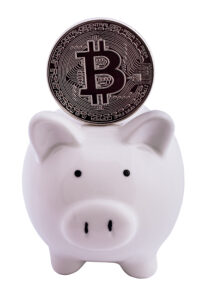
Even though anyone can invest in cryptocurrency, you might be surprised to learn that only around 16% of Americans have purchased or used cryptocurrency. While the overall percentage of Americans who own crypto is low (for now), these early adopters come from all income levels.
So, how much money do you really need to invest in cryptocurrency? There’s no specific answer to this question, and investors in cryptocurrency can trade anywhere from a few dollars to a few hundred thousand or more.
Fractional tokens
Though the price of a single bitcoin is in the tens of thousands, that doesn’t mean that you have to buy a whole coin to invest in the cryptocurrency. Fractional coins are pieces of a cryptocurrency that allow you to take partial ownership of a digital asset like bitcoin.
For example, if bitcoin is trading at $50,000 and you buy $100 of bitcoin, you’ll own fractional shares of bitcoin (0.002 BTC to be exact) that you can trade the same way as if you owned a full bitcoin.
With gold coins and fiat currency, you can purchase smaller denominations, but your options are very limited. You can break down a dollar into cents, and you can buy gold coins that are 1/10 or even 1/20 of an ounce, but even a 1/20 oz gold coin will cost you upwards of $100.
On the other hand, cryptocurrencies are far more divisible than fiat currency and gold. For example, the smallest unit of bitcoin is known as a satoshi (or sat for short), which is 100 millionth of a bitcoin. Just to give you an idea of how incredibly small that is, see the example below:
- BTC price: $46,343
- satoshi price: $0.00004634300000000
- satoshis per penny: 216
Clearly, you don’t need to save up big bucks to start “stacking sats,” as cryptocurrency investors say.
Crypto investment options
Mainstream cryptocurrencies
A cryptocurrency investment can look very different depending on which specific coin you’re purchasing. Trading volume for mainstream cryptocurrencies like bitcoin and ethereum is in the billions of dollars per day, making them highly liquid and therefore fast and easy to buy. You’ll have no trouble trading bitcoin and ethereum, regardless of the amount, and you’ll be able to do so on any cryptocurrency exchange, at any bitcoin ATM, and even in a self-directed IRA.
Specialty and new tokens
Though most people have only heard of a few cryptocurrencies like bitcoin and ethereum, there are actually thousands of cryptocurrencies in existence today. New and specialty tokens can be far more difficult and costly to trade than mainstream cryptocurrencies. Typically, these types of tokens are only available on select exchanges using certain wallets.
In addition, many of these tokens have low liquidity and trading volume, making it a challenge to buy the amount you want at the price you want (bid-ask spread). Specialty tokens may come with strict limits and high fees, so if you’re investing a small amount, you’ll have to be mindful of how these factor into your investment.
Crypto buying options
 When it comes to buying cryptocurrency, one of the easiest ways is through an exchange, like Coinbase or Kraken. Coinbase, for instance, has a minimum buy amount of just two dollars or euros. Kraken has minimums that vary by coin, offering fractional purchases of bitcoin as little as 0.0001 BTC or 0.1 ETH.
When it comes to buying cryptocurrency, one of the easiest ways is through an exchange, like Coinbase or Kraken. Coinbase, for instance, has a minimum buy amount of just two dollars or euros. Kraken has minimums that vary by coin, offering fractional purchases of bitcoin as little as 0.0001 BTC or 0.1 ETH.
Other buying options for crypto include miscellaneous vendors like Robinhood, PayPal, and Venmo. On PayPal and Venmo, you can buy as little as $1 of crypto, while Robinhood’s minimum for bitcoin is 0.000001. On the opposite end of the spectrum, there are upper limits for how much crypto you can trade in a given period. On PayPal, it’s $100,000 per week; Venmo’s limitations are more stringent, allowing users to buy a maximum of $20,000 per week and $50,000 per year.
A third option for buying crypto is through an Individual Retirement Account (IRA). You can invest in your IRA through a bitcoin IRA provider like BitIRA. When investing in cryptocurrency for your IRA, the limiting factors are determined by which exchanges your IRA custodian offers and the annual contribution limits set by the government (for 2022, these are up to $6,000 per year for those under age 50 and $7,000 for individuals 50 and older).
Crypto taxes
Non-IRA crypto
For any cryptocurrency that you’re buying from an exchange or elsewhere outside your IRA, you’ll be responsible for capital gains tax. As with stocks and other securities, profits on investments are subject to short-term or long-term capital gains tax. Income on assets sold that are held for less than one year will be taxed as short-term gains and treated as ordinary income. Long-term capital gains tax applies to income on the sale of assets held for one year or more and are taxed according to the income tiers below.
| Filing Status | 0% Rate | 15% Rate | 20% Rate |
|---|---|---|---|
| Single | Up to $41,675 | $41,676 – $459,750 | Over $495,750 |
| Married filing jointly | Up to $83,350 | $83,351 – $517,200 | Over $517,200 |
| Married filing separately | Up to $41,675 | $41,676 – $258,600 | Over $258,600 |
| Head of household | Up to $55,800 | $55,801 – $488,500 | Over $488,500 |
Source: https://www.bankrate.com/investing/long-term-capital-gains-tax/
IRA crypto
There are two types of IRAs you can invest in–Traditional (non-Roth) IRAs and Roth IRAs. With a Traditional IRA, gains taxes are deferred until you take distributions in retirement. As long as you keep your crypto funds in your IRA, you won’t pay taxes on the income. With a Roth IRA, all contributions are post-tax, so the tax is paid on the money before it’s invested in the account. With a Roth IRA, you won’t pay taxes on your gains so long as you don’t withdraw funds from the account before retirement age (59½). Within an SDIRA, you can invest in bitcoin and other cryptocurrencies.
Terms to Know
- Buy Order – An order to buy an asset
- Sell Order – An order to sell an asset
- Limit Order – A type of order which allows investors to buy or sell at a predetermined price, if and when that price is reached
- Bid – The maximum price someone is willing to pay to buy an asset
- Ask – The lowest price someone would be willing to accept for an asset
- Spread – The difference between the lowest asking price of an asset someone is willing to sell and the highest price someone is willing to pay for that asset
- Average Daily Volume – The number of shares of an asset traded in a given day (averaged over a period of time)
- Minimum Order Size – The smallest amount of an asset you can purchase or sell
- Fractional Tokens – Tokens that represent a denomination that is a fraction of the full token
- Sat or satoshi – The smallest divisible unit of bitcoin, or 0.000000001 BTC
- Wei – The smallest divisible unit of ether, or 0.000000000000000001 ETH. Because this unit is so incredibly tiny, fractional ETH is often expressed in gigawei, or 0.000000001 (the ETH equivalent of a sat).
